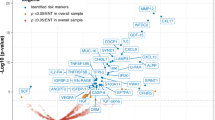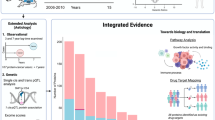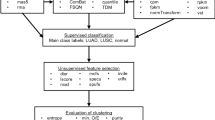Abstract
Background
Plasma proteins are potential biomarkers for complex diseases. We aimed to identify plasma protein biomarkers for lung cancer.
Methods
We investigated genetically predicted plasma levels of 1130 proteins in association with lung cancer risk among 29,266 cases and 56,450 controls of European descent. For proteins significantly associated with lung cancer risk, we evaluated associations of genetically predicted expression of their coding genes with the risk of lung cancer.
Results
Nine proteins were identified with genetically predicted plasma levels significantly associated with overall lung cancer risk at a false discovery rate (FDR) of <0.05. Proteins C2, MICA, AIF1, and CTSH were associated with increased lung cancer risk, while proteins SFTPB, HLA-DQA2, MICB, NRP1, and GMFG were associated with decreased lung cancer risk. Stratified analyses by histological types revealed the cross-subtype consistency of these nine associations and identified an additional protein, ICAM5, significantly associated with lung adenocarcinoma risk (FDR < 0.05). Coding genes of NRP1 and ICAM5 proteins are located at two loci that have never been reported by previous GWAS. Genetically predicted blood levels of genes C2, AIF1, and CTSH were associated with lung cancer risk, in directions consistent with those shown in protein-level analyses.
Conclusion
Identification of novel plasma protein biomarkers provided new insights into the biology of lung cancer.
This is a preview of subscription content, access via your institution
Access options
Subscribe to this journal
Receive 24 print issues and online access
$259.00 per year
only $10.79 per issue
Buy this article
- Purchase on SpringerLink
- Instant access to full article PDF
Prices may be subject to local taxes which are calculated during checkout

Similar content being viewed by others
Data availability
ILCCO data and all GTEx data are publicly available through the database of Genotypes and Phenotypes (dbGaP; Accession No. phs001273.v3.p2; phs000424.v8.p2). Plasma protein prediction models are available from http://nilanjanchatterjeelab.org/pwas.
References
Siegel RL, Miller KD, Wagle NS, Jemal A. Cancer statistics, 2023. CA: Cancer J Clin. 2023;73:17–48.
Bossé Y, Amos CI. A decade of GWAS results in lung cancerGWAS-nominated lung cancer loci. Cancer Epidemiol Biomark Prev. 2018;27:363–79.
Byun J, Han Y, Li Y, Xia J, Long E, Choi J, et al. Cross-ancestry genome-wide meta-analysis of 61,047 cases and 947,237 controls identifies new susceptibility loci contributing to lung cancer. Nat Genet. 2022;54:1167–77.
Wang C, Dai J, Qin N, Fan J, Ma H, Chen C, et al. Analyses of rare predisposing variants of lung cancer in 6,004 whole genomes in Chinese. Cancer Cell. 2022;40:1223–39.
Shi J, Shiraishi K, Choi J, Matsuo K, Chen T-Y, Dai J, et al. Genome-wide association study of lung adenocarcinoma in East Asia and comparison with a European population. Nat Commun. 2023;14:3043.
McKay JD, Hung RJ, Han Y, Zong X, Carreras-Torres R, Christiani DC, et al. Large-scale association analysis identifies new lung cancer susceptibility loci and heterogeneity in genetic susceptibility across histological subtypes. Nat Genet. 2017;49:1126–32.
Gamazon ER, Wheeler HE, Shah KP, Mozaffari SV, Aquino-Michaels K, Carroll RJ, et al. A gene-based association method for mapping traits using reference transcriptome data. Nat Genet. 2015;47:1091–8.
Bossé Y, Li Z, Xia J, Manem V, Carreras‐Torres R, Gabriel A, et al. Transcriptome‐wide association study reveals candidate causal genes for lung cancer. Int J Cancer. 2020;146:1862–78.
Zhu M, Fan J, Zhang C, Xu J, Yin R, Zhang E, et al. A cross-tissue transcriptome-wide association study identifies novel susceptibility genes for lung cancer in Chinese populations. Hum Mol Genet. 2021;30:1666–76.
Pessoa J, Martins M, Casimiro S, Pérez-Plasencia C, Shoshan-Barmatz V. Editorial: Altered expression of proteins in cancer: function and potential therapeutic targets. Front Oncol. 2022;12:949139.
Huang H, Yang Y, Zhu Y, Chen H, Yang Y, Zhang L, et al. Blood protein biomarkers in lung cancer. Cancer Lett. 2022;19:215886.
Guida F, Sun N, Bantis LE, Muller DC, Li P, Taguchi A, et al. Assessment of lung cancer risk on the basis of a biomarker panel of circulating proteins. JAMA Oncol. 2018;4:e182078
Zhou B, Liu J, Wang Z-M & Xi T. C-reactive protein, interleukin 6 and lung cancer risk: a meta-analysis. PLos One. 2012;7:e43075.
Pignatelli B, Li C-Q, Boffetta P, Chen Q, Ahrens W, Nyberg F, et al. Nitrated and oxidized plasma proteins in smokers and lung cancer patients. Cancer Res. 2001;61:778–84.
Ferkingstad E, Sulem P, Atlason BA, Sveinbjornsson G, Magnusson MI, Styrmisdottir EL, et al. Large-scale integration of the plasma proteome with genetics and disease. Nat Genet. 2021;53:1712–21.
Zhang J, Dutta D, Köttgen A, Tin A, Schlosser P, Grams ME, et al. Plasma proteome analyses in individuals of European and African ancestry identify cis-pQTLs and models for proteome-wide association studies. Nat Genet. 2022;54:593–602.
Zhu J, O’mara TA, Liu D, Setiawan VW, Glubb D, Spurdle AB, et al. Associations between genetically predicted circulating protein concentrations and endometrial cancer risk. Cancers. 2021;13:2088.
Shu X, Zhou Q, Sun X, Flesaker M, Guo X, Long J, et al. Associations between circulating proteins and risk of breast cancer by intrinsic subtypes: a Mendelian randomisation analysis. Br J Cancer. 2022;127:1507–14.
Zhu J, Shu X, Guo X, Liu D, Bao J, Milne RL, et al. Associations between genetically predicted blood protein biomarkers and pancreatic cancer riskblood protein biomarkers and pancreatic cancer risk. Cancer Epidemiol, Biomark Prev. 2020;29:1501–8.
Liu J, Li X, Luo X-J. Proteome-wide association study provides insights into the genetic component of protein abundance in psychiatric disorders. Biol psychiatry. 2021;90:781–9.
Wingo TS, Liu Y, Gerasimov ES, Gockley J, Logsdon BA, Duong DM, et al. Brain proteome-wide association study implicates novel proteins in depression pathogenesis. Nat Neurosci. 2021;24:810–7.
The ARIC Investigators. The atherosclerosis risk in communities (ARIC) study: design and objectives. Am J Epidemiol. 1989;129:687–702.
Yang J, Ferreira T, Morris AP, Medland SE. Genetic Investigation of ANthropometric Traits (GIANT) Consortium, DIAbetes Genetics Replication And Meta-analysis (DIAGRAM) Consortium. et al. Conditional and joint multiple-SNP analysis of GWAS summary statistics identifies additional variants influencing complex traits. Nat Genet. 2012;44:369–75.
GTEx Consortium. The GTEx Consortium atlas of genetic regulatory effects across human tissues. Science. 2020;369:1318–30.
Barbeira AN, Dickinson SP, Bonazzola R, Zheng J, Wheeler HE, Torres JM, et al. Exploring the phenotypic consequences of tissue specific gene expression variation inferred from GWAS summary statistics. Nat Commun. 2018;9:1825.
Tang Z, Kang B, Li C, Chen T, Zhang Z. GEPIA2: an enhanced web server for large-scale expression profiling and interactive analysis. Nucleic acids Res. 2019;47:W556–60.
Gahmberg CG, Ning L, Paetau S. ICAM-5: a neuronal dendritic adhesion molecule involved in immune and neuronal functions. Adv neurobiol. 2014;8:117–32.
Soker S, Takashima S, Miao HQ, Neufeld G, Klagsbrun M. Neuropilin-1 is expressed by endothelial and tumor cells as an isoform-specific receptor for vascular endothelial growth factor. Cell. 1998;92:735–45.
Hwang JY, Sun Y, Carroll CR, Usherwood EJ. Neuropilin-1 regulates the secondary CD8 T cell response to virus infection. Msphere. 2019;4:e00221–19.
Torigoe T, Asanuma H, Nakazawa E, Tamura Y, Hirohashi Y, Yamamoto E, et al. Establishment of a monoclonal anti‐pan HLA class I antibody suitable for immunostaining of formalin‐fixed tissue: unusually high frequency of down‐regulation in breast cancer tissues. Pathol Int. 2012;62:303–8.
Chen Y, Lin G, Guo Z-Q, Zhou Z-F, He Z-Y, Ye Y-B. Effects of MICA expression on the prognosis of advanced non-small cell lung cancer and the efficacy of CIK therapy. Plos One. 2013;8:e69044.
Pardoll DM. Stress, NK receptors, and immune surveillance. Science. 2001;294:534–6.
Salih HR, Rammensee H-G, Steinle A. Cutting edge: down-regulation of MICA on human tumors by proteolytic shedding. J Immunol. 2002;169:4098–102.
The Lung Cancer Cohort Consortium (LC3). The blood proteome of imminent lung cancer diagnosis. Nat Commun. 2023;14:3042.
Corrales L, Ajona D, Rafail S, Lasarte JJ, Riezu-Boj JI, Lambris JD, et al. Anaphylatoxin C5a creates a favorable microenvironment for lung cancer progression. J Immunol. 2012;189:4674–83.
Liu S, Tan WY, Chen QR, Chen XP, Fu K, Zhao YY, et al. Daintain/AIF‐1 promotes breast cancer proliferation via activation of the NF‐κB/cyclin D1 pathway and facilitates tumor growth. Cancer Sci. 2008;99:952–7.
Deng J, Fujimoto J, Ye X-F, Men T-Y, Van Pelt CS, Chen Y-L, et al. Knockout of the tumor suppressor gene Gprc5a in mice leads to NF-κB activation in airway epithelium and promotes lung inflammation and tumorigenesislung cancer and inflammation in Gprc5a knockout mice. Cancer Prev Res. 2010;3:424–37.
Melton KR, Nesslein LL, Ikegami M, Tichelaar JW, Clark JC, Whitsett JA, et al. SP-B deficiency causes respiratory failure in adult mice. Am J Physiol-Lung Cell Mol Physiol. 2003;285:L543–9.
Griese M. Pulmonary surfactant in health and human lung diseases: state of the art. Eur Respir J. 1999;13:1455–76.
Gomes M, Teixeira AL, Coelho A, Araujo A, Medeiros R. The role of inflammation in lung cancer. Adv Exp Med Biol. 2014;816:1–23.
Ostrin EJ, Bantis LE, Wilson DO, Patel N, Wang R, Kundnani D, et al. Contribution of a blood-based protein biomarker panel to the classification of indeterminate pulmonary nodules. J Thorac Oncol. 2021;16:228–36.
Sona MF, Myung S-K, Park K, Jargalsaikhan G. Type 1 diabetes mellitus and risk of cancer: a meta-analysis of observational studies. Jpn J Clin Oncol. 2018;48:426–33.
Lippert DN, Wilkins JA. Glia maturation factor gamma regulates the migration and adherence of human T lymphocytes. BMC Immunol. 2012;13:1–11.
Lan A, Ren C, Wang X, Tong G, Yang G. Bioinformatics and survival analysis of glia maturation factor-γ in pan-cancers. BMC Cancer. 2021;21:1–10.
Acknowledgements
The authors would like to thank the Advanced Computing Center for Research and Education (ACCRE) at Vanderbilt University and the Rivanna High-Performance Computing (HPC) system at the University of Virginia, which were used to conduct data analyses. We thank Ms. Kathleen Harmeyer for her assistance in preparing the manuscript.
Funding
This work was supported by the National Institutes of Health grant R01CA249863 (to CQ and LJ). The sponsors had no role in the study design, in the collection, analysis, or interpretation of data, in the writing of the report, or in the decision to submit the paper for publication.
Author information
Authors and Affiliations
Contributions
YY and QC conceived the study. YY and SX analyzed data and drafted the initial manuscript. GJ, FY, JP, XG, RT, XOS, WZ, JL, and QC contributed to the design of the study and revised the manuscript.
Corresponding authors
Ethics declarations
Competing interests
The authors declare no competing interests.
Ethics approval and consent to participate
All included datasets were approved by respective ethics/institutional review committees, in accordance with the Declaration of Helsinki.
Additional information
Publisher’s note Springer Nature remains neutral with regard to jurisdictional claims in published maps and institutional affiliations.
Consent for publication
The manuscript does not contain any individual person’s data.
Supplementary information
Rights and permissions
Springer Nature or its licensor (e.g. a society or other partner) holds exclusive rights to this article under a publishing agreement with the author(s) or other rightsholder(s); author self-archiving of the accepted manuscript version of this article is solely governed by the terms of such publishing agreement and applicable law.
About this article
Cite this article
Yang, Y., Xu, S., Jia, G. et al. Integrating genomics and proteomics data to identify candidate plasma biomarkers for lung cancer risk among European descendants. Br J Cancer 129, 1510–1515 (2023). https://doi.org/10.1038/s41416-023-02419-3
Received:
Revised:
Accepted:
Published:
Issue date:
DOI: https://doi.org/10.1038/s41416-023-02419-3
This article is cited by
-
Post-genome-wide association study dissects genetic vulnerability and risk gene expression of Sjögren’s disease for cardiovascular disease
Journal of Translational Medicine (2025)
-
Causal association between plasma proteins and lung adenocarcinoma: a two-sample mendelian randomization study
BMC Pulmonary Medicine (2025)
-
Systematic proteome-wide Mendelian randomization using the human plasma proteome to identify therapeutic targets for lung adenocarcinoma
Journal of Translational Medicine (2024)



